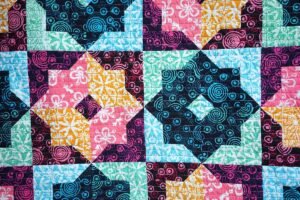Creating the Disappearing Hourglass Moroccan Tiles Quilt offers an exciting experience, blending classic hourglass shapes with an intricate, tile-like effect reminiscent of Moroccan mosaics. This quilt pattern is ideal for quilters seeking a visually striking, geometric design that balances traditional and modern styles. Whether you’re a beginner or an experienced quilter, this pattern’s versatility can fit any decor style, making it a popular choice in the quilting world.
Using the main keywords, “quilt” and “quilt patterns,” this article will walk you through the essentials of the Disappearing Hourglass Moroccan Tiles Quilt—from the necessary fabric cuts to the step-by-step process of piecing your quilt. By understanding how to work with the disappearing hourglass method, quilters can transform simple shapes into stunning, intricate patterns with ease.
In the following sections, we’ll dive into the materials you’ll need, detailed steps for creating the pattern, and helpful tips for achieving professional-looking results. Let’s get started!

Materials and Fabric Requirements for Your Disappearing Hourglass Moroccan Tiles Quilt
To make a Disappearing Hourglass Moroccan Tiles Quilt, selecting quality fabrics and having the right tools are essential. The contrasting colors used in this quilt help create the Moroccan tile effect, so be sure to pick complementary colors for the best results. For this guide, we’ll focus on a quilt that measures approximately 60×60 inches, which is ideal for a throw or lap quilt.
First, gather around 2 yards of fabric A (typically a light color) and 2 yards of fabric B (a darker, contrasting color). This yardage will cover both the quilt top and the backing fabric; if you prefer a larger quilt, adjust the yardage accordingly. You’ll also need a 1/2 yard of border fabric if you plan to frame your quilt with a border, as well as binding and batting of a similar size.
Alongside fabric, be sure to have rotary cutters, rulers, and a sewing machine with quilting needles on hand. You’ll also benefit from a design wall or large surface area where you can lay out your blocks before sewing them together. This setup will make it easier to experiment with different layouts and make adjustments as you go.
Cutting the Fabrics: Preparing Your Hourglass Blocks
The foundation of the Disappearing Hourglass Moroccan Tiles Quilt is the hourglass block, which will later be modified to create the “disappearing” effect. Begin by cutting out squares of fabric A and fabric B. For a 60×60-inch quilt, cut 10-inch squares from both fabrics—around 16 squares each. This size will yield a quilt with blocks measuring about 9 inches after sewing and cutting.
To make each hourglass block, place one square of fabric A and one square of fabric B right sides together. Use a rotary cutter and a ruler to slice these pairs along both diagonals, resulting in four triangles per square pair. Align the edges carefully, and sew the triangles together with a quarter-inch seam allowance, pressing seams open as you go.
After assembling all hourglass blocks, press each one and trim them to a consistent size if needed. At this stage, each block should be roughly 9 inches, depending on your original cuts. Consistent sizing is crucial, as it will ensure clean, even lines when the blocks are pieced together in the next steps.
Creating the Disappearing Hourglass Effect
With your hourglass blocks complete, the next step is to create the “disappearing” effect that gives this quilt its Moroccan tile look. Start by marking vertical and horizontal lines across each hourglass block. For this pattern, divide each side of the block into thirds, marking approximately 3 inches from each edge.
Cut along these marked lines, dividing the block into a nine-patch layout. Carefully rearrange the sections by rotating the center and corner squares 90 degrees, so the colors alternate and form a tile-like appearance. This is what gives the quilt its Moroccan-inspired design.
Repeat this process with each hourglass block, and take your time rearranging each set of nine patches. You may find it helpful to lay out all blocks on a design wall to visualize the final quilt layout before sewing. This approach lets you see the emerging pattern and adjust for balance and symmetry as needed.
Piecing Together the Quilt Top
Once your blocks are arranged to your liking, it’s time to sew the blocks together to create the quilt top. Start by sewing each nine-patch segment back into blocks, using a quarter-inch seam allowance. Take care to match seams precisely, as this will ensure that the disappearing hourglass effect remains uniform across the quilt.
When you have reassembled the blocks, join them row by row. Press seams between rows in alternating directions to help reduce bulk and make it easier to sew the rows together. Pay close attention to how the colors align between rows to maintain the overall pattern’s cohesion.
After piecing all rows, give the quilt top a final press. Consider adding a 1.5-inch border around the quilt to frame the design and give it a polished finish. This step can also help stabilize the edges, especially if you plan to handle the quilt often or add intricate quilting.
Quilting and Binding Your Disappearing Hourglass Moroccan Tiles Quilt
Now that your quilt top is complete, it’s time to layer, quilt, and bind. Begin by layering the quilt top with batting and backing fabric, securing the layers with basting spray or quilting pins. For a Disappearing Hourglass Moroccan Tiles Quilt, a simple grid or diagonal quilting pattern can accentuate the geometric design without overwhelming it.
Using a walking foot, quilt along the edges of each hourglass block or within each nine-patch segment to highlight the disappearing hourglass effect. Straight-line quilting works well for this pattern, as it complements the quilt’s angular design and enhances the Moroccan tile look. If you prefer a softer look, consider free-motion quilting around the block edges.
To finish, trim the edges and bind the quilt. A binding that matches one of the primary colors in your quilt top will provide a cohesive, clean edge. For best results, hand-stitch the binding on the quilt’s back for a polished, professional finish. After binding, your Disappearing Hourglass Moroccan Tiles Quilt is ready to enjoy!
Tips for Achieving the Best Results
Creating the Disappearing Hourglass Moroccan Tiles Quilt is both rewarding and enjoyable, but attention to detail is key. First, take extra time to press each block accurately. Pressing seams open or to the side, depending on bulk, can make a huge difference in how flat and professional your final quilt will look.
Second, use high-quality thread and a fresh needle to ensure your stitches hold firmly, especially with multiple seams. While this quilt pattern may require more cutting than other designs, the results are worth the effort, as the disappearing hourglass effect creates a visually compelling quilt that resembles Moroccan tile work.
Finally, don’t hesitate to experiment with different color combinations. The contrasting colors are essential to creating the Moroccan tile effect, but you can try using a mix of bright and muted colors for a more vibrant, intricate quilt top. Whichever colors you choose, enjoy the process of bringing this beautiful, culturally inspired pattern to life!





